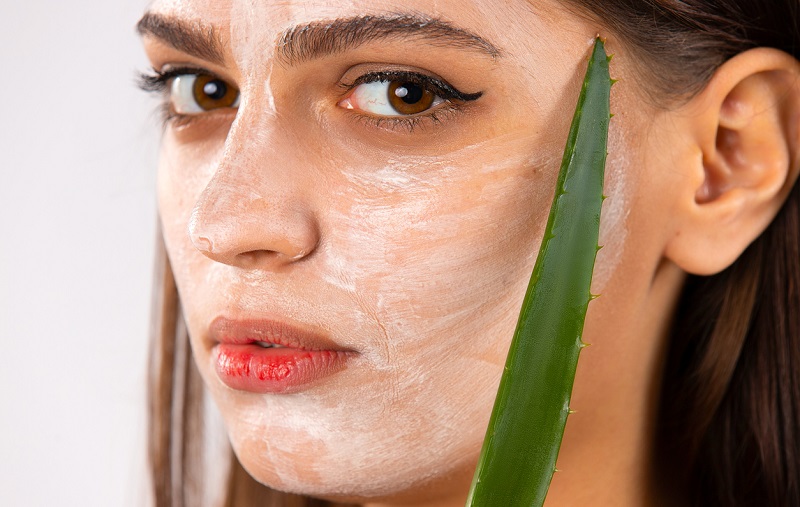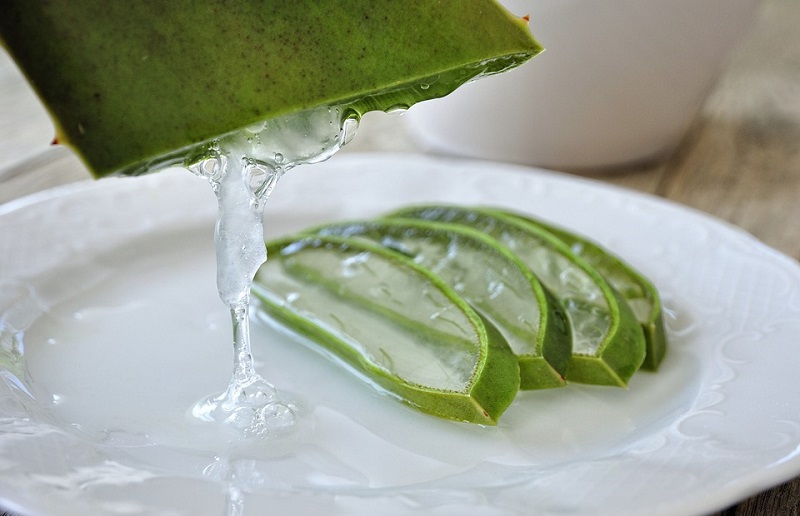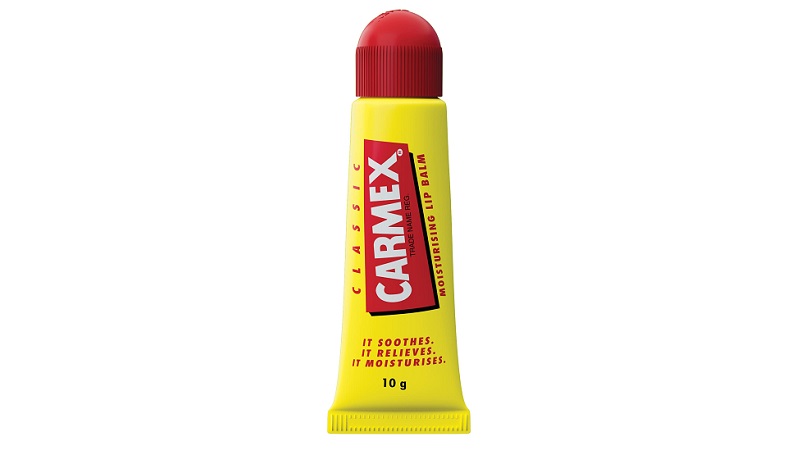Natural cosmetics have been promoted a lot in recent years.
There are many ingredients and herbs used in natural cosmetics. One of them is aloe vera.
Although it became popular as a cosmetic product, it has been used for different purposes throughout the ages.
What is aloe vera?
Aloe vera is a cactus-shaped plant that grows in hot, dry climates. the botanical name is Aloe barbadensis miller.
It grows in arid regions of Africa, Asia, Europe, and America.
Aloe vera has triangular, fleshy leaves with serrated leaves that contain numerous seeds. Each sheet consists of three layers.
The first layer is an inner transparent gel that contains 99% water, and the rest is made of glucomannan amino acids, lipids, sterols, and lipids.
The second or middle layer is a bitter-yellow juice containing anthraquinones and glycosides.
The third layer is the cortex, which consists of 15 – 20 cells that have a protective function and break down carbohydrates and proteins.
What vitamins and minerals are found in aloe vera?
In addition to vitamins and minerals, aloe vera also contains:
– enzymes
– sugars
– anthraquinones
– fatty acids
– hormones
– lignin
– saponin
– salicylic acid and
– amino acids.
– Vitamins – contains vitamins A (beta carotene), C and E, which are antioxidants. In addition, it contains B12, folic acid and choline. Antioxidants neutralize free radicals.
– Enzymes – aloe vera contains 8 enzymes: lipase, alkaline phosphatase, amylase, bradykinase, carboxypeptidase, catalase, cellulase and peroxidase. Bradykinase reduces excessive inflammation when aloe vera is applied to the skin, while other enzymes help break down sugars and fats.
– Minerals – from minerals, aloe vera contains calcium, chromium, copper, selenium, magnesium, manganese, potassium, sodium and zinc.
– Sugars – aloe vera contains monosaccharides (glucose and fructose) and polysaccharides (glucomannan and polymannose). Of the monosaccharides, there is the most mannose-6-phosphate, and the most common polysaccharide is glucomannan. Of all types of glucomannan, aloe vera contains the most acemannan.
– Anthraquinones – aloe vera contains 12 anthraquinones which are traditionally known as laxatives. On the other hand, aloin and emodin act as analgesics.
– Fatty acids contain 4 plant steroids, namely cholesterol, campesterol, β-sitosterol and lupeol. These fatty acids have an anti-inflammatory effect.
– Hormones – aloe vera contains auxins and gibberellins that help heal wounds and have an anti-inflammatory effect.
– Lignin is an internal substance that enhances the penetrating effect of other ingredients on the skin when it is part of certain skin care preparations.
– Saponins – are soapy substances that make up about 3% of aloe vera gel and have skin cleansing and antiseptic properties.
– Amino acids – aloe vera contains 20 to 22 amino acids that humans need and 7 to 8 essential amino acids.
In addition to the above, it also contains salicylic acid, which has anti-inflammatory and antibacterial properties.
Vitamins, minerals and peptides from aloe vera can help if you want to speed up wound healing.
If you have a problem with dandruff, aloe vera can work in the same way, because it has antibacterial properties.
Does aloe vera clog pores?

You will get the answer to the main question of whether aloe vera clogs pores in the following lines.
Since it is light, refreshing and gel-like, it is not dangerous for oily skin and therefore does not lead to clogging of pores.
This means that aloe vera can be used by people with all skin types, because it does not contain a comedogen and therefore does not add fat, it is not dangerous even for those with oily skin.
It even has benefits for oily skin, namely:
- it is a natural astringent – astringents are both a blessing and a curse for oily skin. You’re probably wondering why that is. Astringents usually dry out the skin, but this does not happen with aloe astringents, as aloe vera absorbs excess impurities from the face, while at the same time controlling sebum and neutralizing free radicals on the face in the process.
- non-greasy hydration – many girls make the mistake of using hydrating creams to reduce facial oiliness, because hydrating creams increase facial oiliness even more. It is a completely different story with aloe vera, because it has a high level of water in it and it hydrates the face without additional oils.
- prevents acne – many girls with oily skin are prone to pimples and acne. Aloe vera helps to remove dirt from the face that leads to acne, and at the same time, it is antibacterial and keeps pimples and acne under control.
- aloe vera has a soothing effect – many girls have problems with acne and pimples, and aloe vera contains certain enzymes that reduce the redness and inflammation caused by pimples on the face.
- removes acne scars – many girls have problems with acne scars. They tried to remove them in many different ways, but the only cure for acne scars is aloe vera, because it contains certain proteins that have anti-inflammatory properties that lead to the healing of acne scars.
Free radicals destroy skin collagen and cause blemishes on oily skin.
They can be removed with the help of aloe vera, because it contains antioxidant properties that neutralize free radicals and thus prevent skin damage.
Which benefits of aloe vera for the face?
As I mentioned before, aloe vera has vitamins A, C, E and B12 in its gel and for this reason it has anti-inflammatory properties, which means it helps reduce pain, swelling and injuries.
In addition, aloe vera has other benefits for facial skin such as:
– increases collagen,
– accelerates the healing time of wounds and limits scars,
– accelerates the healing of first and second degree burns,
– is very effective in the treatment of fungal and bacterial infections
– slows down the aging process of the skin and leads to the repair of sun-damaged skin, cools skin affected by rashes and sun-damaged,
– it is excellent in hydrating the skin, because aloe vera contains 99% water,
– aloe vera skin becomes more flexible and supple.
5 ways you can use aloe vera in your DIY skin- and hair-nourishing recipes
If you have read the section on vitamins and minerals in aloe vera, you will understand this section more easily, because all the listed components that makeup aloe vera are mentioned in the following lines.
Many people want to make natural preparations for quality skin and hair care.
Aloe vera in combination with other ingredients is best for that. Here are 5 ways you can make DIY skin and hair care products:
- Mask for deep cleansing of the scalp
If you want to make a shampoo for deep cleansing of the scalp, you need to take the gel from the aloe vera plant and mix it with apple cider vinegar and lemon juice. Massage it on your scalp and then rinse it off.
- Hair paste that fights frizz
If your hair is frizzy, it means that there is no moisture in your hair. To bind moisture to the hair, use aloe vera because it contains molecules of pectin and sugar.
In addition, aloe vera also contains amino acids that contain proteins that can strengthen damaged hair.
It is best to mix it with avocado because it leaves the surface of the basket shiny and thus reflects light.
Apply the resulting paste on wet hair and wash it off after 30 minutes.
- Soothing eye makeup remover
In some girls, the skin around the eyes is prone to flaking or redness, instead of a makeup remover you can use a mixture of aloe vera and coconut oil.
This mixture is excellent because at the same time, it removes makeup and the skin around the eyes is as soft as before makeup.
- Mask for acne-prone skin
Aloe vera is excellent for treating acne because it contains salicylic acid. Salicylic acid helps to renew skin cells and thus prevents the clogging of pores.
That’s why the best mask for acne-prone skin is a mixture of aloe vera and honey.
- Eyebrow strengthening gel
As already mentioned, aloe vera contains enzymes that help repair dead skin cells, while hydrating and strengthening hair follicles.
That’s why it’s best to mix castor oil with aloe vera and apply it to your eyebrows with a mascara wand.
What are the types of aloe vera?

Although it may sound impossible there are 300 varieties of aloe vera.
However, only three or four species have their own medicinal properties.
The first species I will write about was already mentioned at the beginning of the article, and it is Aloe Barbadensis Miller.
This name also serves as the technical name for aloe vera.
It is the most famous of all types of aloe vera. In order to recognize it, you should know that it is 1m tall and that its leaves grow vertically.
Its leaves are green with white stamens that disappear as the aloe vera grows.
At the end of the leaves there are small pointed threads.
It is used to treat burns and remove scars.
Another species of Aloe Arborescens is known as a relative of Aloe Vera, because they look similar and have similar properties.
This type of aloe vera has a different shape compared to the previous type of aloe vera. It has large fleshy green leaves and grows in the form of a bush. It looks like an octopus and has no teeth on the edges of the leaves.
The third type of Aloe Saponaria – this type of aloe vera is known by the name Pita Real. And its leaves are fleshy and contain a high content of aloe juice.
This type of aloe has leaves of a different color – they are bluish green or reddish brown, with whitish spots and thorns.
It has yellow and or red flowers on top. The properties of this aloe vera are similar to the properties of the first aloe vera. It is used to treat sunburn, but it is also used to treat heart problems.
The fourth type of Aloe Ferox is one of the most different types and you can easily recognize it. Its stem can grow from 2 to 3 meters.
Its leaves grow in a rosette, and its leaves are tall, gray-green with reddish spines at the ends.
Unlike the previous species, this type of aloe vera has laxative properties, but it is also used to heal and improve burns.
Should and how should you eat aloe vera?
I’m sure many are wondering if aloe vera is only used in cosmetics or if it can also be used in the kitchen as a dish. Due to its composition, it gives a refreshing taste to meals and drinks.
The only concern is latex, which can lead to cancer. That’s what the researchers concluded after a research study.
In addition, latex can cause diarrhea or stomach cramps.
To avoid side effects, you can easily separate it from aloe vera.
When you buy groceries, you can also buy aloe vera specifically, but you should make sure that the leaves are full, without spots.
Aloe vera leaves can be eaten raw or cooked. To prepare it, you need to peel the skin of aloe vera. You can remove the gel with a spoon.
To remove the latex, you need to wash the gel well, and you will recognize the latex by its yellow color.
Aloe vera gel cleaned in this way can be eaten raw or cooked. You can do this in several ways such as poaching, blanching or steaming. When aloe vera is cooked, it releases water and gives it a milder taste.
What are the benefits of drinking aloe vera juice?
Aloe vera, in addition to having benefits when used for cosmetic purposes, also has benefits when drunk as juice.
You can read some of the benefits of aloe in the previous parts of this article, but here are also benefits that are related to the health of the whole organism. Benefits include:
- Excellent anti-inflammation – this means the treatment of burns and wounds, because they contain antioxidants. Antioxidants protect your body from damage caused by free radicals, better known as oxidative stress.
- Helps to improve the condition of the skin – in addition to helping to heal burns and faster healing of wounds, aloe vera also helps to increase collagen, which leads to reduced wrinkles and skin elasticity.
- It can be used in the treatment of pre-diabetes – old studies have shown that the use of both gel and juice can reduce blood sugar levels if taken on an empty stomach by people with pre-diabetes.
- Helps with digestive problems – as already mentioned, aloe vera contains anthraquinones that have a laxative effect. Some research shows that aloe vera can help if you have digestive problems.
- Helps improve dental and oral health – there is more research showing that aloe vera is great for dental and oral health.
Some research was done on animals, while others were done on people suffering from throat cancer.
A large number of cancer patients have experienced reduced pain from chemotherapy after using aloe vera mouthwash.
Aloe vera has also helped in less risky dental diseases.
Aloe vera and history
Aloe vera has been used for centuries as a medicine in several cultures: Greece, Egypt, India, Mexico, Japan and China.
Egyptian queens Nefertiti and Cleopatra used it in their daily beauty routine, while Alexander the Great and Christopher Columbus used aloe vera to treat wounds.
Until the beginning of the 19th century, it was used as a laxative in the USA, and from 1930 it began to be used for skin diseases.
No matter how medicinal and healthy aloe vera is, before you start using it, consult your doctor, because he will tell you to what extent it is best to use aloe vera in order to really feel the benefits of aloe vera.
Don’t miss these topics:




